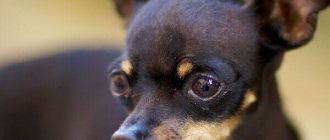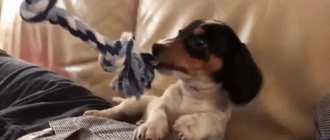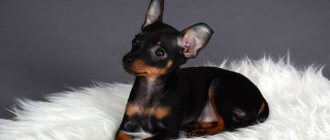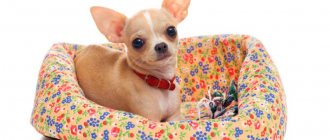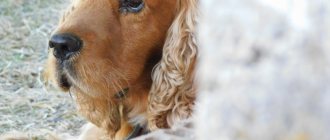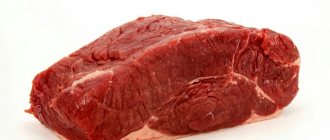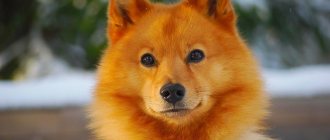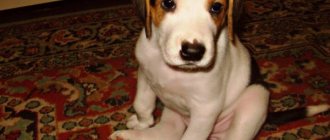Breed characteristics
| Short description | |
| Origin: | Czech Republic |
| Conditions of detention: | Private house or apartment |
| Purpose: | Hunter, companion |
| Color: | With tan – black, brown, blue (the rarest); deer, marble |
| Wool length: | For short-haired dogs 0.5 – 1 cm, for long-haired dogs from 1 cm on the body to 6 cm on the feathers |
| Adult dog size: | Height from 18 to 22 cm, average weight 2.5 kg (no more than 2.6 kg) |
| Average life expectancy: | 12 – 14 years old |
| Walk: | Daily walks of up to 1 hour per day are required |
| Physical activity needs: | High level of needs |
| Fédération Cynologique Internationale (FIC) classification: | Not recognized by the IFF |
| Puppy price: | From 15 thousand rubles. for a puppy without documents, from 100 thousand rubles. for a show class dog |
History of the origin of the species
The reliable history of the appearance of the Prague rat is unknown. The breed is shrouded in a lot of legends, which one to believe is up to everyone to decide for themselves. The first descriptions of a similar dog date back to the 7th century.
The Great Inquisition brought the greatest popularity to little rat catchers. Cats were considered evil spirits, assistants to witches and servants of the devil, and sanitary conditions left much to be desired - ideal conditions for the breeding of rats. Rodents, carriers of plague, posed a real threat not only to crops, but also to people. It was small dogs that helped get rid of the hordes of rats that attacked medieval Europe.
Rats were given to the monarchs of Germany, France, and England as a sign of deep respect. Prince Borislav the Smely was known as the greatest connoisseur of the breed, and it was thanks to him that the rat dog found its way into the highest houses of Western Europe.
The Soviet occupation of the Czech Republic led to the death of the breed's livestock , the disbandment of nurseries, and the loss of stud books. Breeders and breed lovers had to revive the Ratliks bit by bit. Only towards the end of the 19th century did the number of individuals cease to be critical. But until now, the Liben chamois remains a rare breed.
Ratlik is still recognized by the International Cynological Federation. But the breed was included in the lists of other, no less authoritative cynological organizations, including the RKF.
Distinctive features
The main distinguishing characteristics of the Prague rat rats are:
- General form. A small dog of almost square format (extension index for males is 100 to 105, for females 100 to 110), agile and active.
- Head. Small, proportional to the body, pear-shaped, dry. The forehead is moderately wide, the cheekbones do not protrude, and the brow ridges are well defined. The transition from the forehead to the nose is significantly pronounced. The ears are set high and wide apart, triangular in shape. The eyes are large, round, widely set, dark (almost black).
- Muzzle. Narrow, smooth, slightly longer than the skull. From the nose to the forehead it widens slightly. The bridge of the nose is slightly turned up or straight. The nose is small, pigmented black or similar to the main color. Scissor bite. Teeth set – 42 pieces.
- Neck. Lean, muscular, slightly elongated and curved, without dewlap. The transition from the neck to the back (withers) is poorly defined.
- Frame. The shoulder blades are muscular, set obliquely. The chest is broad, falling below the elbows, with moderately sprung ribs. The back is straight, without sagging, strong. The stomach is significantly tucked in. The loin is rounded and short.
- Tail. Set low, carried above the level of the back. Long above the hock or docked to the third vertebra.
- Limbs. The limbs are parallel to each other, the pasterns are gathered into a ball, the hock joints have pronounced angles.
- Sexual dimorphism. Moderately expressed, females are smaller and lighter than males (welcome).
Appearance
Prague rat rats are considered the most dwarf breed on the planet. In accordance with the standard, a minimum height at the withers is indicated for them in comparison with Chihuahuas, for which only weight parameters are established. The height of an adult male is 19-23 cm, females - 17-20 cm. The standard weight for a male is 2-2.2, maximum - 2.6 kg, females - 1.8-2.0 kg. The dogs are harmoniously built, the ratio of height to body length should be 1:1.05, and the volume of the chest should be 2 times the height. They have strong bones, clearly defined lean muscles, a compact body with a straight back. The dog is characterized by agile, coordinated movements.
Head
The width and length of the pear-shaped head should be the same. On it, at the level of the lumbar region, a rounded occipital convexity is clearly expressed. The prominent, prominent, square-shaped forehead with convex brow ridges is divided by a clear demarcation line.
Read Pomsky - Spitz and Husky in one dog
Eyes
Compactly adjacent eyelids are located straight. Dark brown (almost black) eyes are set wide apart and harmonize with the color. They are expressive, slightly protruding, so they give the dog a slightly perplexed look.
Ears
Almost motionless triangular ears are located vertically and slightly at an angle. Strong, proportionate shells consist of dense cartilaginous tissue. Their tips may hang forward.
Jaws
The standard for the breed is considered to be strong, well-formed jaws with a regular scissor bite and parallel incisor teeth. Symmetrical teeth are usually quite large for a small dog. A full set of teeth is desirable, but dogs without first molars are assessed according to the standard.
Torso
The body of rat rats is square-shaped, while that of females is slightly elongated. This is associated with the birth of puppies. Chest height is half the height. The level loin is strong, the oblong croup is sloping. The groin area is selected and forms a graceful curve with the chest line. The shoulder blades, tightly adjacent to the body, are equipped with developed muscles.
Neck
The firmly set, graceful long neck is beautifully arched. There are no skin folds on it.
Tail
In a calm state, the dog's tail is located at the level of the back or hangs down. In a fit of inspiration, it rises slightly or is curled into a ring. In young puppies it is stopped at the level of the fourth vertebra.
Paws
The widely spaced limbs of the ratlik are quite muscular. Especially noticeable are the parallel, longer hind legs with strong tendons and developed muscle tissue. They are grouped into a hard ball and end in fingers brought together with curved black claws.
Wool
The short (sometimes half-length) shiny coat of dogs that lies close to the body is easy to care for. In short-haired rat rats, dense, identical hairs on the body and paws grow intensively. On the head they are shorter and sparse; longer on paws, tail, ears.
Color
The standard provides for the main colors of the breed:
- coal (maybe with scorch marks);
- brown (often with spots);
- red (all shades - from pale to dark yellow);
- chocolate;
- marble.
The tan marks should be sharply different from the main color and stand out clearly against its background. Most often they are found on the muzzle, neck, tail area and inner thighs. Two triangular hourglass-shaped markings look impressive. Fuzzy spots are a deviation from the breed characteristics. Such dogs do not participate in breeding.
Marble colored dogs are rare and are popular among breeders.
Photo of an adult dog
Photos of puppies
Features of character and behavior
Ratlik is a serious working dog, unlike decorative toy terriers and chihuahuas . The character of the ratter corresponds to the work of a hunter - courage, perseverance and intelligence are the main character traits of a small dog. At the same time, the rat does not like to bark without a reason, it is not aggressive towards others, but at the sight of danger it will boldly rush to protect its owner or property.
The Libeńska serochka is an ideal companion; it subtly senses the owner’s mood . Balanced and calm - when the owner needs it, and runs happily to play - when a person calls for a walk. Ratlik is too independent to impose his company on the owner on his own.
Despite its very modest stature and miniature size, the rat is a working breed that has not lost its purpose in modern times. This is an active, lively dog that needs a lot of physical activity . Ratliks play well with children, but only older ones: a small child can accidentally injure a tiny and fragile rat.
Ratliks get along well with other animals, even cats. But, due to character traits and a well-developed hunting instinct, you should not have rats, mice, guinea pigs or birds in a house where a rat rat lives.
With timely socialization, the rat will find a common language even with large dogs and will be happy to communicate and play with them. Just be sure to make sure that the baby is not offended by larger dogs . Otherwise, the fear of big dogs will remain for life.
Advantages
The main advantages of the Prague ratr are:
- Easy to care and maintain;
- Mental balance;
- Courage;
- Activity;
- Mind;
- Attachment to family;
- Unobtrusiveness;
- Possibility to maintain even in a small apartment.
Flaws
The main disadvantage of the ratlik is its overdeveloped hunting instinct - this can be dangerous in urban areas. The owner will have to constantly monitor the pet so that the dog does not get hit by a car and gets lost.
Education and socialization
Typically, miniature dogs are quite hysterical and difficult to control, but the Czech Ratlik is an exception. He is smart, obedient and trusting. This set of qualities makes him a good student.
He remembers the rules invented by his household very quickly. It socializes and adapts well, but only on condition that the owner is always nearby. Requires a good-natured educational approach. Shouting and cursing during teaching will definitely not bring results to the teacher. Remember, you need to communicate with the rat rat gently and at the same time persistently.
You shouldn’t forbid him to climb onto the sofa/bed/chair. If you notice that the dog is chewing shoes, curtains or other objects, scold him. Don't let them bite, especially puppies! Baby rats often bite the hands of household members when their teeth are renewed.
This is how they try to reduce the pain. We recommend providing them with a baby pacifier or rubber ducky to play with. Interaction with such objects has a positive effect on the animal’s psyche.
Walk your dog often to keep him active and happy. Go with her to nature, to the river or to the forest. Mischievous and energetic warriors love to explore new areas. You can safely let them off the leash without fear of them running away or hiding.
Care and maintenance
It is strictly forbidden to keep rat rats in the open air all year round . Their short coat and complete lack of undercoat does not protect them from bad weather. The baby's place should be in the house, in a warm place without drafts. Otherwise, ratliks are absolutely unpretentious in maintenance, the main condition is to prevent hypothermia.
Caring for eyes and ears does not require special skills. It is enough to wipe your eyes with a special lotion for eye hygiene 1 or 2 times a week. Ears need cleaning even less often - no more than once every 2 weeks; this also requires a special ear cleaner. Apply the lotion to a cotton pad and wipe the inside of the ear with it.
There is no need to try to clean the entire ear canal yourself (so as not to injure the dog); it is enough to wipe only the visible part of the ear.
trim the nails as they grow, under the light weight of the dog, they do not grind down on their own. Trimming claws must be done very carefully so as not to injure the inner “living” part of the claw. Or use the services of a veterinarian or professional groomer.
after teeth carefully and brush them every week with a special toothpaste for dogs. Additionally, give chewable treats against tartar. Visit the veterinarian at least twice a year to have your teeth examined; if necessary, the doctor will prescribe laser cleaning against tartar plaque.
Nutrition
Prague rats are famous gluttons, so the owner will have to be meticulous in selecting the dog’s diet and serving size. It is acceptable to eat ready-made industrial feed (not lower than super-premium class) or natural food (not from the human table).
Despite the dog’s miniature size, when choosing food we must not forget that it is a predator. Ready-made food contains all the necessary substances to maintain an ideal balance in the animal’s body - a good option for owners who do not want to delve into the intricacies of their pet’s digestion. But with natural feeding there are quite a few nuances that should not be forgotten.
Products that must be present in a rat's diet:
- Lean meat (beef, horse meat, chicken, turkey, rabbit);
- Eggs (chicken or quail);
- Cottage cheese, other fermented milk products with a reduced fat content;
- Vegetables and fruits (preferably raw) are sources of fiber (except potatoes and overly sweet fruits such as grapes or watermelon);
- Cartilage, tendons and offal;
- Source of complex carbohydrates (rice is best) - no more than 10% of the total diet;
- Low-fat boiled fish without bones (no more than once a week).
Prohibited foods in the diet of the serochka:
- Sweets and chocolate;
- Flour (except for dried rye bread);
- Fatty meat (lamb, pork);
- Boiled meat and bones (heat treatment destroys part of the protein contained in the meat, and the sharp edges of the bones injure the esophagus);
- Salt, pepper and other spices;
- Smoked meats, pickled products.
Regardless of the chosen diet, an adult ratlik does not need to be fed, more than twice a day.
- It is best to feed puppies up to 4 months in small doses every 2 to 3 hours;
- From 4 to 6 months 5 times a day at equal intervals;
- From 6 to 10 months 4 times a day, at 10 – 12 months 3 times a day;
- After 12 months, you can switch the puppy to the diet of an adult dog.
We recommend that you read a detailed article on the topic: “How and what to feed a dog: types and characteristics of nutrition.”
Health
Miniature breeds are rarely completely healthy, and the Prague rat is no exception. Despite their rather long lifespan (some individuals live up to 16 years), ratliks are predisposed to a number of diseases.
Due to the lack of undercoat, they often suffer from viral infections (rhinitis, conjunctivitis) resulting from hypothermia.
Conscientious breeders try to make the breed healthier by not allowing sick individuals into breeding. But so far it is in vain, the very small size of the dog does not allow this.
Vaccinations
Before the first vaccine against viral infections (canine distemper, viral hepatitis, enteritis), the entire litter, together with the mother, must undergo double helminthization, with an interval of 10 - 14 days . Only 2 weeks after repeated prophylaxis of worms can the first immunization be given (at the age of 8 - 10 weeks ).
The veterinarian may prescribe a product with a wider range of strains, depending on the progress of infections in a particular region.
21 - 28 days after the first vaccination, the injection is duplicated to enhance the effect. Even after revaccination, it is advisable to observe another 2 weeks of quarantine until immunity is fully formed. By the time of the double vaccination, the puppy is ready for the rabies vaccine; depending on the state of health and the conditions of keeping the little Ratlik, the veterinarian may delay immunization until the teeth are completely changed.
The last vaccination is given at the age of 12 months, and each subsequent year is repeated along with rabies.
Important article on the topic: “Everything you need to know about dog vaccinations.”
Diseases
Like most compact breeds, Ratlik is susceptible to a number of diseases:
- Dislocation of the knee or elbow joints;
- Ligament ruptures and fractures;
- Cataract;
- Allergic manifestations and dermatitis;
- Obesity;
- Gastrointestinal disorders;
- Pancreatitis;
- Sugar dermatitis;
- Early tooth loss.
With proper care, proper maintenance, and timely visits to the veterinarian, the Prague rat will delight its owners with excellent health.
Walk
Despite the fact that a chamois can easily be trained to use a tray or a sanitary diaper, walking in the fresh air is necessary for such active dogs. When walking in the cold season, it is better to insulate your pet by wearing special clothes and shoes, or reduce the walking time to 20 - 30 minutes a day .
Due to pronounced hunting instincts, the ratlik should not be allowed to roam freely without a leash . The pet can chase any little thing that looks like prey - small birds, squirrels, even a leaf blown by the wind along the road - the rat will be interested in everything that moves. In the city, such chases can turn into disaster - the baby can get hit by a car or get lost.
An address on the dog's collar will not be superfluous; if the dog gets lost, there are high chances that caring people will return him.
Grooming
The short coat of the Libeni serochka does not require special care. It is enough to use a brush with natural bristles or a special rubber glove once a week. You don’t need to bathe your dog often either - about 5-6 times a year (or as needed).
Long-haired representatives of the breed need to be combed more often, especially the feathers on the ears and paws - approximately once every 2 days.
Possible diseases and methods of treating them
There are practically no specific diseases for Prague rat rats. They are strong, have strong immunity, but periodically get sick, like all living creatures. Most representatives of the breed end up seeing a veterinarian due to diseases of the oral cavity, and more often – diseased teeth.
For most owners, cleaning a miniature dog's mouth is a big challenge. When plaque accumulates on the teeth, they begin to hurt a lot. As a result, the animal loses appetite and weight. Prevention is regular cleaning of his mouth with a brush.
Also, some rat rats often experience luxation of the kneecap, especially those who move a lot. In this case, you should provide the dog with rest and hospitalize it. One final piece of advice: keep your pet warm in the cold in winter, as his thin skin and short fur make him very cold.
Mating
According to the regulations “On Breeding Work” of the Russian Cynological Federation , individuals who have reached the age of 18 months are allowed for breeding . In females, breeders focus on the third heat, which in small dogs usually occurs closer to two years. Potential parents must be vaccinated, wormed and completely healthy.
The mating day is scheduled for the 10th – 14th day of estrus; deviations of 1 – 2 days in both directions are acceptable, depending on the physiology of the female. A day after fertilization, a double mating is carried out to give breeders complete confidence in pregnancy.
Multiple pregnancies are rare for dwarf breeds; normally, ratliks have litters of 2–4 puppies.
Read a detailed article on the topic: “Everything you need to know about breeding dogs: appropriate age, what to do if it doesn’t work out, rules and tips.”
Reproduction and lifespan
The average lifespan of the Prague rat rat is 14 years. If a dog is seriously ill for a long time, then its service life will barely be 10-12 years. It is important to always monitor your pet's health!
Males regularly show sexual interest in females, especially when they are in heat. Breeders know that after the female starts menstruating, she should wait 3 to 5 days before mating, because this way the likelihood of conception is much higher.
Only fully mature and psychologically stable dogs can be bred. They must be of high quality, otherwise the breeder will not make money selling puppies. Pregnancy in a female Prague rat rat lasts no more than 73 days.
When choosing a puppy, pay attention to its behavior. The dog should not be lethargic or motionless. Choose the one who approaches you first! This is classic advice from breeders.
Key points in training
Despite the general opinion that small dogs are too stupid and cannot be trained. Prague Rat Dogs are increasingly appearing in sports training competitions - agility, Frisbee Dog, OKD - and show not the worst results. Ratliks have mental abilities on par with shepherd dogs, and are happy to learn new commands and tricks.
The gluttony of the little rat-catchers plays into the hands of the instructors; for a piece of their favorite delicacy, the serochka will carry out any order. Training with positive reinforcement takes place in a positive way - the dog exercises with pleasure, commands are remembered quickly and easily.
Read about how to properly train a dog in the article: “Training a puppy: effective methods from dog handlers, learning commands at home.”
The rat will not tolerate harsh methods of education - it will snap or even try to escape from the owner. These little dogs have such ambitions that a Rottweiler would be jealous.
Nicknames
Choosing a name for a miniature dog should be approached responsibly. A sonorous, playful nickname should match the appearance and character of the pet, and this can be done by observing the puppy’s behavior for several days. Nicknames appropriate for the Prague rat rat:
| For boys | For girls |
| Henri | Arlette |
| Barney | Bonnie |
| Krosh | Bridget |
| Maurice | Maggie |
| Nils | Nellie |
| Oscar | bliss |
| Pixel | Nora |
| Simon | Paris |
| Chucky | Trixie |
| Alvin | Fanny |
How to choose a puppy
The choice of a future pupil should be based on an understanding of why the puppy is being purchased. The cost and appearance of the dog depends on this. Puppy class options:
- Show class . The highest price is for dogs of this particular class ( about 100 thousand rubles and above). The puppies have the ideal breed exterior to become show champions.
- Breeding class . The price for a puppy is slightly lower than for exhibitions ( 50 – 70 thousand rubles ). The pet has all the characteristics of the breed, but is perhaps a little larger than miniature show dogs. Ideal for breeding.
- Pet class . A dog of this group has the lowest price ( 25 - 30 thousand rubles ), but at the same time there is a full package of documents confirming that it belongs to the breed. The main reason why a pet-class ratlik is not suitable for exhibitions or breeding is, as a rule, a slight deviation from the standard. But this will not prevent such a puppy from becoming a pet or a winner of sports competitions.
It is not advisable to buy a Prague rat rat from your own hands, without a pedigree - the resemblance to that terrier and chihuahua can play a cruel joke. Unscrupulous breeders can deceive an inexperienced dog breeder and sell a more common (and therefore cheaper) dog at triple the price as a rare breed.
Pros and cons of the breed
Before purchasing a Czech Ratlik puppy, to avoid disappointment, experts advise weighing their advantages and disadvantages.
There are enough positive qualities in dogs:
- intelligence and ingenuity;
- devotion to your family and sincere love for the owner;
- fearlessness in protecting the owner from large dogs;
- the ability to signal the presence of strangers in the home;
- miniature parameters ideal for keeping in a limited area;
- basic care and a small amount of food.
The weaknesses of the breed include:
- tendency to overeating and obesity;
- susceptibility to colds;
- commitment to storing food in unpredictable hiding places.
These deficiencies can be overcome by carefully monitoring your pet.
Breed nurseries
List of nurseries where you can safely buy a ratlik and not be afraid of being deceived:
- https://ratlikdog.ru/kontakty.html St. Petersburg, mono-breed nursery “GALIVAS”;
- https://www.prazsky-krysarik.ru/ Moscow, nursery “From the constellation Niki”;
- https://www.ratlik.org/ Moscow, nursery “Ratlik-blues”;
- https://krysarik.ucoz.ru/ Moscow, nursery “Grand League”;
- https://www.millgret.breeder.ee/ Estonia, Tallinn, nursery “Millgret”.
The Prague Rat is a breed that, once settled in a house, will remain there forever. The love of this little dog is so selfless and boundless that it wins a person’s heart for life.
5 / 5 ( 1 voice )
Price
Those wishing to purchase a valuable canine companion should be prepared to pay a decent amount of money for it. Czech warriors are loved for their extraordinary devotion, good nature and ability to “neutralize” rats that are unpleasant for many people and cause trouble.
So, the price of a Prague rat rat in modern Russia with a pedigree is from 1000 dollars. There is a nursery in Moscow where such puppies are raised. It's called Ratlik blues. When you see these dogs, you will probably be confused; their charm will amaze anyone. But the staff of the capital's nursery will definitely help you make the right choice of dog.
